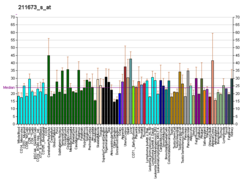MOCS1
| MOCS1 | |||||||||||||||||||||||||||||||||||||||||||||||||||
|---|---|---|---|---|---|---|---|---|---|---|---|---|---|---|---|---|---|---|---|---|---|---|---|---|---|---|---|---|---|---|---|---|---|---|---|---|---|---|---|---|---|---|---|---|---|---|---|---|---|---|---|
| Identifiers | |||||||||||||||||||||||||||||||||||||||||||||||||||
| Aliases | MOCS1, MIG11, MOCOD, MOCODA, molybdenum cofactor synthesis 1, MOCS1A, MOCS1B | ||||||||||||||||||||||||||||||||||||||||||||||||||
| External IDs | OMIM: 603707; MGI: 1928904; HomoloGene: 129502; GeneCards: MOCS1; OMA:MOCS1 - orthologs | ||||||||||||||||||||||||||||||||||||||||||||||||||
| |||||||||||||||||||||||||||||||||||||||||||||||||||
| |||||||||||||||||||||||||||||||||||||||||||||||||||
| |||||||||||||||||||||||||||||||||||||||||||||||||||
| |||||||||||||||||||||||||||||||||||||||||||||||||||
| |||||||||||||||||||||||||||||||||||||||||||||||||||
| Wikidata | |||||||||||||||||||||||||||||||||||||||||||||||||||
| |||||||||||||||||||||||||||||||||||||||||||||||||||
Molybdenum cofactor biosynthesis protein 1 is a protein that in humans and other animals, fungi, and cellular slime molds, is encoded by the MOCS1 gene.[5][6] [7] [8]
Both copies of this gene are defective in patients with molybdenum cofactor deficiency, type A.[8]
Molybdenum cofactor biosynthesis is a conserved pathway leading to the biological activation of molybdenum. The protein encoded by this gene is involved in molybdopterin biosynthesis. (This gene was originally thought to produce a bicistronic mRNA with the potential to produce two proteins (MOCS1A and MOCS1B) from adjacent open reading frames. However, only the first open reading frame (MOCS1A) has been found to encode a protein from the putative bicistronic mRNA.) Two of the splice variants found for this gene express proteins (MOCS1A-MOCS1B) that result from a fusion between the two open reading frames.
References
- ^ a b c GRCh38: Ensembl release 89: ENSG00000124615 – Ensembl, May 2017
- ^ a b c GRCm38: Ensembl release 89: ENSMUSG00000064120 – Ensembl, May 2017
- ^ "Human PubMed Reference:". National Center for Biotechnology Information, U.S. National Library of Medicine.
- ^ "Mouse PubMed Reference:". National Center for Biotechnology Information, U.S. National Library of Medicine.
- ^ "MOCS1 - Gene - NCBI". www.ncbi.nlm.nih.gov. Retrieved 19 July 2018.
- ^ Reiss J, Cohen N, Dorche C, Mandel H, Mendel RR, Stallmeyer B, Zabot MT, Dierks T (Oct 1998). "Mutations in a polycistronic nuclear gene associated with molybdenum cofactor deficiency". Nat Genet. 20 (1): 51–3. doi:10.1038/1706. PMID 9731530. S2CID 23833158.
- ^ Reiss J, Dorche C, Stallmeyer B, Mendel RR, Cohen N, Zabot MT (Apr 1999). "Human molybdopterin synthase gene: genomic structure and mutations in molybdenum cofactor deficiency type B". Am J Hum Genet. 64 (3): 706–11. doi:10.1086/302296. PMC 1377787. PMID 10053004.
- ^ a b "Entrez Gene: MOCS1 molybdenum cofactor synthesis 1".
Further reading
- Reiss J, Johnson JL (2003). "Mutations in the molybdenum cofactor biosynthetic genes MOCS1, MOCS2, and GEPH". Hum. Mutat. 21 (6): 569–76. doi:10.1002/humu.10223. PMID 12754701. S2CID 41013043.
- Shalata A, Mandel H, Reiss J, et al. (1998). "Localization of a gene for molybdenum cofactor deficiency, on the short arm of chromosome 6, by homozygosity mapping". Am. J. Hum. Genet. 63 (1): 148–54. doi:10.1086/301916. PMC 1377237. PMID 9634514.
- Feng G, Tintrup H, Kirsch J, et al. (1998). "Dual requirement for gephyrin in glycine receptor clustering and molybdoenzyme activity". Science. 282 (5392): 1321–4. Bibcode:1998Sci...282.1321F. doi:10.1126/science.282.5392.1321. PMID 9812897.
- Reiss J, Christensen E, Kurlemann G, et al. (1999). "Genomic structure and mutational spectrum of the bicistronic MOCS1 gene defective in molybdenum cofactor deficiency type A.". Hum. Genet. 103 (6): 639–44. doi:10.1007/s004390050884. PMID 9921896. S2CID 5247017.
- Reiss J, Christensen E, Dorche C (1999). "Molybdenum cofactor deficiency: first prenatal genetic analysis". Prenat. Diagn. 19 (4): 386–8. doi:10.1002/(SICI)1097-0223(199904)19:4<386::AID-PD550>3.0.CO;2-#. PMID 10327149. S2CID 196592216.
- Gray TA, Nicholls RD (2000). "Diverse splicing mechanisms fuse the evolutionarily conserved bicistronic MOCS1A and MOCS1B open reading frames". RNA. 6 (7): 928–36. doi:10.1017/S1355838200000182. PMC 1369970. PMID 10917590.
- Hänzelmann P, Schwarz G, Mendel RR (2002). "Functionality of alternative splice forms of the first enzymes involved in human molybdenum cofactor biosynthesis". J. Biol. Chem. 277 (21): 18303–12. doi:10.1074/jbc.M200947200. PMID 11891227.
- Gross-Hardt S, Reiss J (2003). "The bicistronic MOCS1 gene has alternative start codons on two mutually exclusive exons". Mol. Genet. Metab. 76 (4): 340–3. doi:10.1016/S1096-7192(02)00100-2. PMID 12208140.
- Strausberg RL, Feingold EA, Grouse LH, et al. (2003). "Generation and initial analysis of more than 15,000 full-length human and mouse cDNA sequences". Proc. Natl. Acad. Sci. U.S.A. 99 (26): 16899–903. Bibcode:2002PNAS...9916899M. doi:10.1073/pnas.242603899. PMC 139241. PMID 12477932.
- Mungall AJ, Palmer SA, Sims SK, et al. (2003). "The DNA sequence and analysis of human chromosome 6". Nature. 425 (6960): 805–11. Bibcode:2003Natur.425..805M. doi:10.1038/nature02055. PMID 14574404.
- Ota T, Suzuki Y, Nishikawa T, et al. (2004). "Complete sequencing and characterization of 21,243 full-length human cDNAs". Nat. Genet. 36 (1): 40–5. doi:10.1038/ng1285. PMID 14702039.
- Hänzelmann P, Hernández HL, Menzel C, et al. (2004). "Characterization of MOCS1A, an oxygen-sensitive iron-sulfur protein involved in human molybdenum cofactor biosynthesis". J. Biol. Chem. 279 (33): 34721–32. doi:10.1074/jbc.M313398200. PMID 15180982.
- Gerhard DS, Wagner L, Feingold EA, et al. (2004). "The status, quality, and expansion of the NIH full-length cDNA project: the Mammalian Gene Collection (MGC)". Genome Res. 14 (10B): 2121–7. doi:10.1101/gr.2596504. PMC 528928. PMID 15489334.
- Ichida K, Aydin HI, Hosoyamada M, et al. (2007). "A Turkish case with molybdenum cofactor deficiency". Nucleosides Nucleotides Nucleic Acids. 25 (9–11): 1087–91. doi:10.1080/15257770600894022. PMID 17065069. S2CID 40601679.
- v
- t
- e
| Vitamin A | |
|---|---|
| Vitamin E | |
| Vitamin D |
|
| Vitamin K |
| Thiamine (B1) | |||||
|---|---|---|---|---|---|
| Niacin (B3) | |||||
| Pantothenic acid (B5) | |||||
| Folic acid (B9) | |||||
| Vitamin B12 | |||||
| Vitamin C | |||||
| Riboflavin (B2) | |||||
| Tetrahydrobiopterin | |||||
|---|---|---|---|---|---|
| Molybdopterin | |||||
 | This article on a gene on human chromosome 6 is a stub. You can help Wikipedia by expanding it. |
- v
- t
- e



















